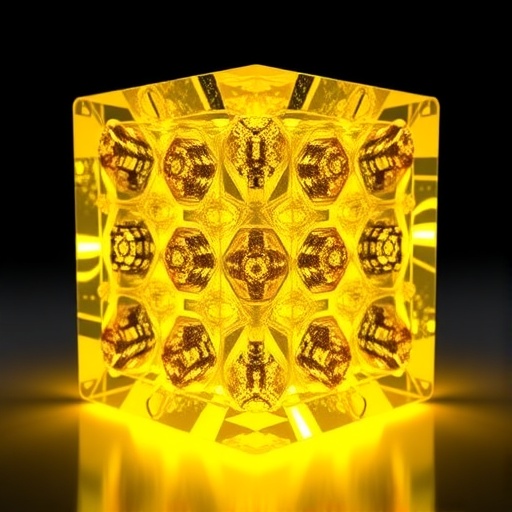A recent breakthrough in electrocatalyst development has emerged from a research team led by Professor Ge Lei at the China University of Petroleum (Beijing). This study focuses on a novel tungsten doping strategy that plays a critical role in enhancing the stability and performance of manganese-based bimetallic phosphide, specifically W-CoMnP. This innovative approach effectively addresses the well-known Jahn-Teller effect that causes detrimental disproportionation and dissolution in manganese compounds. The findings, published in the prestigious Chinese Journal of Catalysis, showcase significant implications for energy conversion technologies, especially in the realm of hydrogen production.
Manganese-based materials have garnered attention for their potential in catalyzing important electrochemical reactions, yet their stability remains a significant challenge. The Jahn-Teller effect can induce structural distortions in certain metal oxides, leading to performance degradation. By employing tungsten doping during the synthesis phases of transition bimetallic phosphides, the research team managed to stabilize the electronic structures of manganese-based catalysts, mitigating these unfavorable conditions. This breakthrough positions W-CoMnP as a viable candidate for anion exchange membrane (AEM) water electrolyzers, which are pivotal for sustainable hydrogen production.
Electrolyzers are fundamental in renewable energy systems, allowing the conversion of electrical energy into chemical energy stored in hydrogen. The newly developed W-CoMnP catalyst distinguishes itself by exhibiting exceptional bifunctionality, performing well in both the hydrogen evolution reaction (HER) and oxygen evolution reaction (OER). Tests demonstrated that the catalyst can achieve low overpotentials of 95 mV at 10 mA cm⁻² for HER and 225 mV at 50 mA cm⁻² for OER, indicative of its efficiency in catalyzing these reactions.
In practical applications, the performance of W-CoMnP has been remarkable, with a cell voltage as low as 1.52 V maintained stably for over 24 hours during continuous operations in AEM electrolyzers. This characteristic showcases the material’s potential for real-world applications, particularly in generating clean hydrogen gas under ambient conditions. The simple template-free method utilized for synthesizing cobalt and manganese precursors streamlines the production processes, offering an attractive path towards scalable manufacturing of efficient catalysts.
The theoretical understanding of W-CoMnP further solidifies its innovative design. Utilizing electrostatic field theory and density functional theory (DFT) calculations, the researchers revealed how doping with tungsten alters the electronic characteristics of the catalyst. Such alterations lead to the creation of unsaturated Co and Mn sites, enhancing the material’s ability to facilitate desirable adsorption phenomena crucial for catalytic performance. These findings offer a comprehensive framework for manipulating the electronic structure of manganese-based electrocatalysts to optimize performance.
Moreover, this research illuminates a critical pathway towards resolving the spin state issue posed by Mn³⁺ cations within the bimetallic structure. The team’s hypothesis suggests that controlling the spin state alleviates Jahn-Teller distortions, thereby reinforcing the stability of Mn-based materials. With the introduction of tungsten into the system, the spin state of Mn tends to transition to a low-spin configuration. This spin state alteration fundamentally changes the electronic landscape, allowing for improved catalytic performance without the adverse effects of distortion.
Furthermore, the results echo the growing need for sustainable and efficient energy solutions in combating climate change. The methodology outlined in this study can serve as a foundational approach to developing future catalysis technologies that are both economically viable and environmentally friendly. By transitioning from traditional fossil fuels to hydrogen as a clean energy source, the advancements in electrocatalytic materials such as W-CoMnP can significantly alleviate reliance on non-renewable energy sources.
In addition to the scientific implications, the publication in the Chinese Journal of Catalysis underscores the urgency of advancing research in applied catalysis. With a high impact factor of 17.7, the journal has established itself as a cornerstone in disseminating cutting-edge developments in the field. The editorial board, comprised of distinguished researchers, ensures that all contributions undergo rigorous peer-review processes, maintaining the integrity and quality of the research shared with the global scientific community.
By leveraging these insights garnered from their pioneering work, the research team at the China University of Petroleum has set a precedent for future studies aimed at improving the efficacy of electrocatalysts. Their findings pave the way for further exploration into other complementary doping strategies that could be applied to various catalytic systems aiming for improved operational stability and performance.
This study not only elucidates the profound impact of doping strategies in enhancing electrocatalytic performance but also highlights the collaborative efforts of academic institutions and research centers in advancing the field of green energy technologies. As the global community pivots towards sustainability, innovations like W-CoMnP will play a crucial role in meeting the increasing demand for energy solutions that are both efficient and environmentally responsible.
In conclusion, the groundbreaking work on W-CoMnP represents a significant advancement in electrocatalytic research, demonstrating the potential of tungsten doping to stabilize manganese-based compounds while simultaneously enhancing their performance. As scientists continue to uncover the complexities of these materials, the promise of high-performance, stable electrocatalysts for clean energy applications looms ever closer.
Subject of Research: Tungsten-doped bimetallic phosphide electrocatalyst for hydrogen production
Article Title: Developing a stable and high-performance W-CoMnP electrocatalyst by mitigating the Jahn-Teller effect through W doping strategy
News Publication Date: 24-Jul-2025
Web References: Chinese Journal of Catalysis
References: DOI: 10.1016/S1872-2067(25)64669-9
Image Credits: Credit: Chinese Journal of Catalysis
Keywords
Applied sciences and engineering




